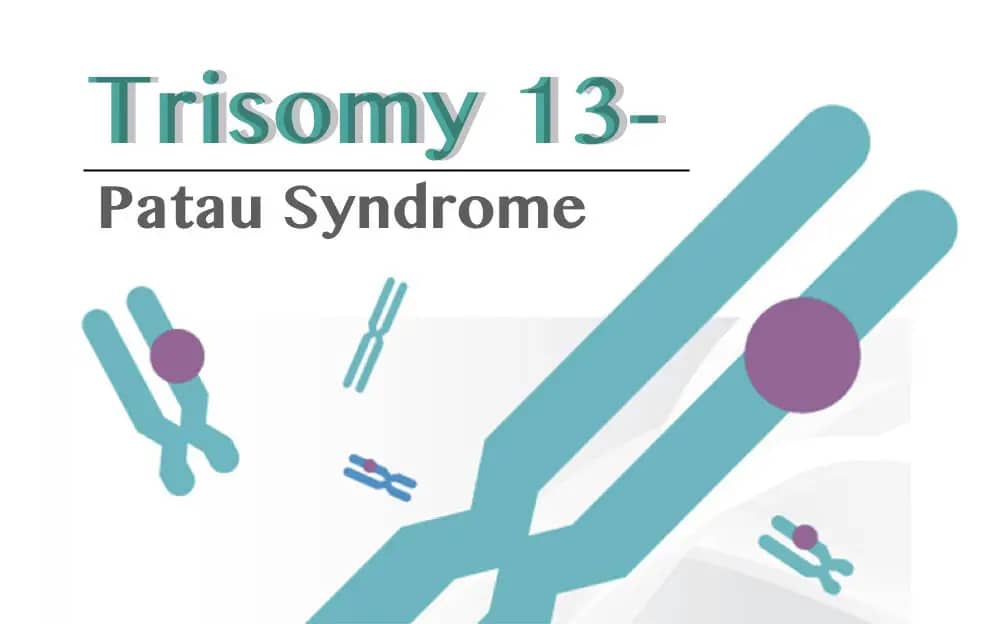
Trisomy 13, also known as Patau syndrome, is a genetic disorder that occurs when a baby has an extra copy of chromosome 13 in their cells. Normally, humans have 23 pairs of chromosomes, with one set inherited from each parent. In trisomy 13, however, there are three copies of chromosome 13 instead of the usual two, leading to an imbalance of genetic material. This extra genetic material disrupts the normal course of development, causing a variety of health problems throughout the body.
Symptoms:
The full penetrance of the disease is shown in the complete trisomy and highly depends on the amount of extra genetic material inherited. Usually, the present condition causes serious mental, intellectual and developmental abnormalities. Common symptoms include
- Close-set or closely located eyes
- Coloboma- a hole in the iris of the eye
- Low-set ears
- Seizures
- Inguinal and umbilical hernia
- Skeletal abnormalities
- Microcephaly- small head
- Small jaw (especially lower)
- Cryptorchidism- is the condition with an undescended testicle.
- Absence of eyeballs
- Abnormal share of the pelvic girdle bone
- Abnormal cranial structure
- Congenital heart defects
- Cleft palate or lip
- Extra toes (polydactyly)
- Decrease muscle tone
- Breathing and feeding problems
- Congenital trigger digits
- Prominent heel
- Overlapping fingers over the thumb
- Kidney defect
- Defective head
- Low birth weight
- Underdeveloped nostrils
Life expectancy
T13 is the second most common trisomy after Down syndrome showing serious and complicated health issues. Commonly, an infant with trisomy 13 dies immediately after birth or in a few hours. In some cases, a baby can live up to weeks, however, below 10% of babies with trisomy 13 can live up to a year. The mortality rate of the fetus with trisomy 13- Patau syndrome is very high like trisomy 18.
Diagnosis:
Ultrasound and genetic analysis are mainly used to diagnose trisomy 13
Ultrasound – It is the primary screening method that provides indications early in pregnancy. However, genetic testing or cytogenetic analysis must be required for validating the ultrasound indications.
Cytogenetic analysis- Amniotic fluid or chorionic villi sample is taken and cultured for to obtain dividing cells that are in the metaphase stage. Metaphases are cultured, harvested, and stained by Giemsa and GTG banding. The chromosome plates are later observed under a microscope to investigate chromosomal aberrations.
Another emerging genetic testing method nowadays scientists are using is known as cell-free DNA testing in which circulating fragments of fetal DNA are isolated from the mother’s blood and employed for encountering trisomy.
Treatment options
Though the mortality rate of Patau syndrome is high, individuals with less serious symptoms can survive in some cases if proper treatment is given in the early days. There is no medication to treat Patau syndrome but medication and other services can be offered to improve their quality of life. For example, speech and mental treatment or therapies are given to improve patients’ psychological and mental health. Surgeries can be used to repair heart defects or cleft lips. Occupational therapy, physical treatment, psychological counselling, motor skills improvement therapy, and other different approaches may also improve the quality of life of the patients.
Conclusion
Trisomies are commonly found, though trisomy 13 or Patau syndrome isn’t very common, it’s a problematic condition. The mortality rate is very high, having serious developmental complications.
Conclusively, trisomy 13 is a non-inherited genetic (more precisely) chromosomal aberration that causes serious health problems. Prenatal diagnosis is the only way to prevent Patau syndrome, to date, no medications or treatment for trisomy 13 are available.
